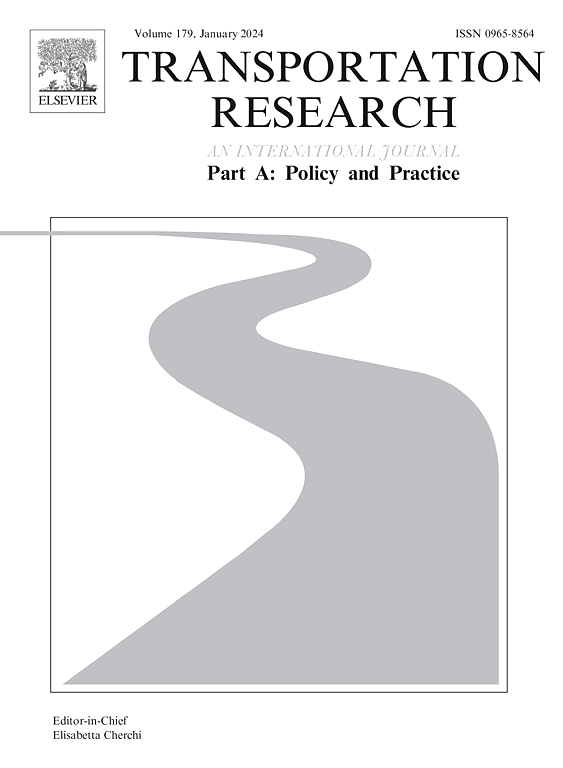Towards completely caring 15-minute neighbourhoods
IF 6.3
1区 工程技术
Q1 ECONOMICS
Transportation Research Part A-Policy and Practice
Pub Date : 2025-05-26
DOI:10.1016/j.tra.2025.104503
引用次数: 0
Abstract
The “15-Minute City” concept has been embraced by global leaders to promote human-scale neighbourhoods with transport and land-use designs that support short trips to daily necessities. This paper bridges the 15-Minute City to “Mobility of Care”, a framework that foregrounds travel to care destinations, travel done predominately by women. This focus contrasts the more commonly studied travel to employment and leisure destinations. While the 15-Minute City concept is flexible enough to consider all destination types, gendered examinations are relatively lacking in the literature, and little research to date has focused explicitly on care destinations. This gap is addressed in this paper by identifying which areas in the city of Hamilton, Canada are ‘caring 15-minute neighbourhoods’. To do so, a database of care destinations was compiled to estimate the number (using the cumulative opportunity accessibility measure) and diversity of mix (using an entropy measure) of care destinations within a 15-minute walk from residential parcels. Using data-driven machine learning techniques (Self-Organizing Maps and Decision Trees), neighbourhoods were classified into ‘caring 15-minute neighbourhood’ typologies that are examined across residential socio-economic profiles. Our results suggest that the majority of caring 15-minute neighbourhoods are in the urban core, where more lower-income households currently reside. In contrast, areas that lack caring 15-minute neighbourhoods are in higher-income peripheral areas. Areas that make good candidates for urban policy intervention are identified and the implications of enhancing 15-minute walkable caring access are discussed in relation to equtiy and gender mainstreaming in transportation planning and limitations of this work.
走向完全有爱心的15分钟社区
“15分钟城市”的概念已经被全球领导者所接受,通过交通和土地利用设计来促进人类尺度的社区,支持短途旅行到日常必需品。本文将“15分钟城市”与“护理流动性”联系起来,这是一个框架,突出了前往护理目的地的旅行,主要是女性。这种重点对比了更普遍研究的旅游就业和休闲目的地。虽然15分钟城市概念足够灵活,可以考虑所有目的地类型,但文献中相对缺乏性别检查,迄今为止很少有研究明确关注护理目的地。本文通过确定加拿大汉密尔顿市的哪些地区是“爱心15分钟社区”来解决这一差距。为此,编制了一个护理目的地数据库,以估计从住宅地块步行15分钟内的护理目的地的数量(使用累积机会可达性度量)和组合多样性(使用熵度量)。使用数据驱动的机器学习技术(自组织地图和决策树),将社区划分为“关怀15分钟社区”类型,并在住宅社会经济概况中进行检查。我们的研究结果表明,大多数有爱心的15分钟社区位于城市核心,那里目前居住着更多的低收入家庭。相比之下,缺乏关爱的15分钟社区的地区位于收入较高的周边地区。确定了适合城市政策干预的领域,并讨论了与交通规划中的公平和性别主流化有关的加强15分钟步行护理的影响以及这项工作的局限性。
本文章由计算机程序翻译,如有差异,请以英文原文为准。
求助全文
约1分钟内获得全文
求助全文
来源期刊
CiteScore
13.20
自引率
7.80%
发文量
257
审稿时长
9.8 months
期刊介绍:
Transportation Research: Part A contains papers of general interest in all passenger and freight transportation modes: policy analysis, formulation and evaluation; planning; interaction with the political, socioeconomic and physical environment; design, management and evaluation of transportation systems. Topics are approached from any discipline or perspective: economics, engineering, sociology, psychology, etc. Case studies, survey and expository papers are included, as are articles which contribute to unification of the field, or to an understanding of the comparative aspects of different systems. Papers which assess the scope for technological innovation within a social or political framework are also published. The journal is international, and places equal emphasis on the problems of industrialized and non-industrialized regions.
Part A''s aims and scope are complementary to Transportation Research Part B: Methodological, Part C: Emerging Technologies and Part D: Transport and Environment. Part E: Logistics and Transportation Review. Part F: Traffic Psychology and Behaviour. The complete set forms the most cohesive and comprehensive reference of current research in transportation science.

 求助内容:
求助内容: 应助结果提醒方式:
应助结果提醒方式:


